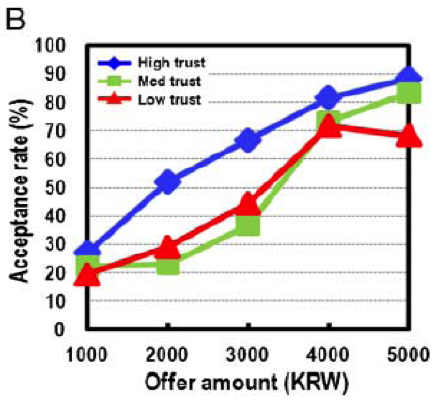






Your Custom Text Here
Who We Are
The Laboratory of Social and Decision neuroscience is a social and decision-making neuroscience research group (Director: Hackjin Kim, Ph.D.) at the Department of Psychology in Korea University.
What We Do
At the most general level, the aim of our research is to reveal the psychological and neural mechanisms underlying decision-makings that support social, emotional or economic behaviors.
At a more detailed level, we are currently interested in finding new answers to a variety of questions including the facial expression perception, preference judgments, empathy, fairness perception, social comparison, social conformity, ethical consumption, and altruistic behaviors.
In order to address these research questions, we use brain-imaging methods mainly including functional magnetic resonance imaging (fMRI).
In collaboration with other groups, we're also trying to adopt various other methodological approaches including electroencephaography (EEG), event-related potentials (ERPs), transcranial magnetic stimulation (TMS) and eye-tracking.
Preference judgments of one over other options form the basis of various types of decision-making and can be often formed rapidly without conscious efforts. We have revealed that the nucleus accumbens (NAC) and the medial orbitofrontal cortex (mOFC), two key brain regions implicated in reward processing, are involved in preference judgment when choosing between two face stimuli. In addition, we found that NAC can rapidly and automatically respond to preferred faces whereas mOFC responds to preferred faces more slowly and consciously. (Kim et al., PNAS, 2007).
In order to make decisions between disparate rewards such as when choosing between buying a refrigerator and booking a vacation, it is often suggested that the value of these rewards needs to be encoded on a “common scale or currency” so that it is possible to work out which option is more preferable to that individual. In this fMRI study, we found partially overlapping value-related activity within ventromedial prefrontal cortex (vmPFC) during anticipation of juice and money reward outcomes, whereas the right anterior insula showed negative correlations as a function of increasing expected reward. These results indicate that vmPFC and anterior insula contain overlapping representations of anticipatory value, consistent with the existence of a common currency for the value of expected outcomes in these regions. (Kim et al., Cerebral Cortex, 2011).
Emotional and social information conveyed by faces can be detected rapidly and implicitly by our brain and influence our decisions during social interactions. In a fMRI study using the Ultimatum games, a well-known economic game, we found that responder’s fairness judgment can be influenced by facial trustworthiness of proposer, and the lateral orbitofrontal cortex plays a key role in this process by integrating signals from various emotional structures such as the amygdala and the insula (Kim et al., Journal of Cognitive Neuroscience, 2012).
Prosocial choices, albeit not immediately related to one’s own profit, can be critical for establishing and maintaining successful social life in human society. Participants performed a gambling task on behalf of themselves or another person inside the MRI scanner. We found that the activation of the amygdala and the dorsomedial prefrontal cortex (DMPFC) were associated with value computations for oneself and for another, respectively, during risky financial decisions. (Jung et al., Frontiers in Neuroscience, 2012).
In daily interactions, we often estimate another person’s preferences accurately even on the basis of minimal information about the person. In this study, participants estimated others’ preferences above chance level, based only on a brief exposure to their appearances. fMRI data showed that higher accuracy in preference estimation was associated with greater activity in the dorsomedial prefrontal cortex (DMPFC) when participants were guessing the targets’ preferences relative to thinking about their own preferences. On the contrary, the tendency to refer to self-preferences when estimating others’ preference was related to greater activity in the ventromedial prefrontal cortex (Kang et al., Frontiers in Human Neuroscience, 2013).
Contrary to traditional economic models, social comparison influences subjective utility and decision-making such that our decisions are influenced not only by absolute payoffs but also by relative income difference between self and others. We examined the behaviors and neural response patterns of Korean (i.e., interdependent culture) and American (i.e., independent culture) participants while performing a financial gambling task simultaneously and independently with a partner. Upon seeing the partner’s income, greater modulation of the activity in the ventral striatum (VS) and the ventromedial prefrontal cortex (vmPFC) by relative gain was observed in Korean than American participants, suggesting greater sensitivity of Koreans toward social comparison. The strength of functional connectivity between the VS and the vmPFC predicted individual variability in the degree to which participants’ decisions were affected by relative incomes (Kang et al., Journal of Neuroscience, 2013).
Neural Basis of Ethical Consumption (Daehyun Jung) and Moral Judgments Under the Observation by Others (Minwoo Lee)
Neural Mechanism of Similarity-liking Effect (Pyungwon Kang)
Neural Markers of Individual Variability in Prosocial Propensity within the Medial Prefrontal Cortex (Sunhae Sul)
The Effect of Intranasal Oxytocin Administration on Social Comparison (Eunyoung Kim) and Moral Judgments (Minwoo Lee)
Neural Mechanism of Social Influence on Preference Judgments (Heejung Jung)
Reputational Concern and Self-referential Processing (Kwangwook Kim)
Neural Basis of Individual Variability in Empathy and Perspective-taking (Nuri Kim)
Neural Mechanism of Illusory Correlation and its Role in the Formation of Social Stereotypes (Minsun Kim)
Neural Basis of Moral Parochialism (Leehyun Yoon)